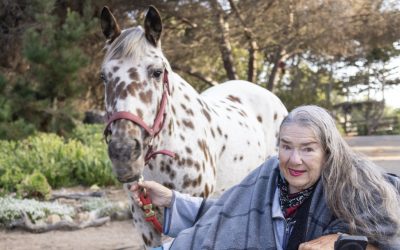“Managing this year on an empty stomach is our unthinkable reality. Sustainable recovery, for those who are impacted, will likely be measured in years, not months, not weeks, and many of you have leaned in. Thank you so much,” said Garrett Olson, CEO of the SLO Food Bank during a brief presentation at a weekly COVID-19 briefing in December 2020.
The former Fire Chief for the City of San Luis Obispo, with a long professional background in logistics management, Olson has a gift for quick summation (not always shared by this writer). But lengthy breakdowns of the previous year’s timeline have been inescapable, even now heading into the second month of 2021, so we won’t use this space to dwell too much on the annum that seems never to end.
Reinforcing Olson’s points, the very name of the troublesome novel coronavirus first described by science in 2019 means that it now bridges three calendar years of human attention. In that time our species has learned at least as much about ourselves as it has the internal workings of a nasty replicating collection of proteins and genetic sequences. The world population very much “leaned in” through a year of crisis. Two vaccines are authorized (as of January 2021) for distribution in the United States, with three more in phase three clinical trials.
The emergency room physician, Dr. Clint Slaughter, who we spoke with in April of 2020 for the May issue, recently shared on social media an image of himself receiving his second of two required vaccination doses. Displaying some irrepressible whimsy, for the occasion he wore a Hawaiian shirt and a helmet from the Disney-produced Star Wars TV show, The Mandalorian.
Reinforcing Olson’s points, the very name of the troublesome novel coronavirus first described by science in 2019 means that it now bridges three calendar years of human attention. In that time our species has learned at least as much about ourselves as it has the internal workings of a nasty replicating collection of proteins and genetic sequences. The world population very much “leaned in” through a year of crisis. Two vaccines are authorized (as of January 2021) for distribution in the United States, with three more in phase three clinical trials.
The emergency room physician, Dr. Clint Slaughter, who we spoke with in April of 2020 for the May issue, recently shared on social media an image of himself receiving his second of two required vaccination doses. Displaying some irrepressible whimsy, for the occasion he wore a Hawaiian shirt and a helmet from the Disney-produced Star Wars TV show, The Mandalorian.
“This is the way,” that is to say, the manner in which so many led by example through the last 10 months of unrelenting crisis. Doctors and nurses will still be taking every physical precaution as the infection caseload reaches new daily highs, but for frontline professionals who receive the vaccine, one fear at least is being lifted. They no longer have to be as concerned that the compassion they show on the job will mean bringing the pathogen home to their families.
For members of our communities who have escaped infection but now have so much less than they did before, or who live (for this moment) in fear of not knowing where their next meal is coming from, it may help to know that they haven’t been given up on. The simple act of feeding each other, to make sure your neighbor’s belly is as full as your own, is a civilization-old pursuit cutting across class, culture, and hopefully still, ideology.
“We continue to provide compassionate hunger relief at historic rates throughout SLO County,” Olson told the virtual audience at the briefing. “According to the California Association of Food Banks, hunger in 2020 skyrocketed an astounding 154 percent. Our experience validates that sobering statistic. We are on track to provide over 5 million pounds of food for our struggling neighbors throughout the entire county. That’s 153 percent of the 3.2 million pounds of food that we provided in 2019. We’ve been busily providing food through our 60 distribution sites and through 82 partner non-profit agencies to meet this tragic need.”
For members of our communities who have escaped infection but now have so much less than they did before, or who live (for this moment) in fear of not knowing where their next meal is coming from, it may help to know that they haven’t been given up on. The simple act of feeding each other, to make sure your neighbor’s belly is as full as your own, is a civilization-old pursuit cutting across class, culture, and hopefully still, ideology.
“We continue to provide compassionate hunger relief at historic rates throughout SLO County,” Olson told the virtual audience at the briefing. “According to the California Association of Food Banks, hunger in 2020 skyrocketed an astounding 154 percent. Our experience validates that sobering statistic. We are on track to provide over 5 million pounds of food for our struggling neighbors throughout the entire county. That’s 153 percent of the 3.2 million pounds of food that we provided in 2019. We’ve been busily providing food through our 60 distribution sites and through 82 partner non-profit agencies to meet this tragic need.”
With 30 employees and 250 volunteers, Olson added that the contribution of labor hours could be measured at over a thousand per month, time spent making it possible for others not to worry about where to find a hot meal.
“We’ve not run out of food, nor have we been forced to ration, nor have we deviated from our high standards of nutrition,” Olson explained, “because we know that hungry people don’t just need food to fill a belly. Hungry people need nutritious food to fuel their bodies and their minds.”
On a phone call in January 2021, Judith Smith-Meyer, Marketing Communications Manager for the Foodbank of Santa Barbara County described how her agency had managed a hard shift in focus through the last year, escalating their distribution from a high of 10 million pounds of food in most years to 18 million during COVID-19.
“Demand and distribution is about double our normal levels,” she said. “Santa Maria in our North County is where we have the highest concentration of poverty, taking in roughly two-thirds of our distribution. Lompoc and Santa Maria together would be three-quarters, but this year our South County operations have been half of our output.”
Individual communities on their map developed need overnight. Carpinteria specifically saw an April to June increase of 1,300 percent. That’s not a typo, Smith-Meyer assured. These sudden needs under- score a reliance on a tourism economy affecting every level of the community. In the County of San Luis Obispo, reports at that time indicated 20,000 of the County’s 283,354 people filed for unemployment, and pick-ups at some of the SLO Food Bank’s distribution sites tripled in the weeks that followed. They now attempt to meet the needs of 70,000 people who come to them, said Olson.
A difference between the two cooperating organizations, said Smith-Meyer, was borne out of earlier tragedy. As the Santa Barbara organization stretched to meet the overnight needs of an additional 55,000 individuals of the County’s 446,499 population, they had a brand-new emergency action plan to follow.
Developed in response to the Thom- as Fire and the Montecito mud and debris flows, the Foodbank of Santa Barbara County had a countywide emergency preparedness feeding plan ready to get food distribution as close to people trapped at home as possible. While what they anticipated were natural disasters that might block local roads and Highway 101 for weeks on end, “What we ended up doing was getting to people who couldn’t come to us because of the virus instead,” said Smith-Meyer, “a different kind of disaster, but we were very glad to have the infrastructure in place.”
“We’ve not run out of food, nor have we been forced to ration, nor have we deviated from our high standards of nutrition,” Olson explained, “because we know that hungry people don’t just need food to fill a belly. Hungry people need nutritious food to fuel their bodies and their minds.”
On a phone call in January 2021, Judith Smith-Meyer, Marketing Communications Manager for the Foodbank of Santa Barbara County described how her agency had managed a hard shift in focus through the last year, escalating their distribution from a high of 10 million pounds of food in most years to 18 million during COVID-19.
“Demand and distribution is about double our normal levels,” she said. “Santa Maria in our North County is where we have the highest concentration of poverty, taking in roughly two-thirds of our distribution. Lompoc and Santa Maria together would be three-quarters, but this year our South County operations have been half of our output.”
Individual communities on their map developed need overnight. Carpinteria specifically saw an April to June increase of 1,300 percent. That’s not a typo, Smith-Meyer assured. These sudden needs under- score a reliance on a tourism economy affecting every level of the community. In the County of San Luis Obispo, reports at that time indicated 20,000 of the County’s 283,354 people filed for unemployment, and pick-ups at some of the SLO Food Bank’s distribution sites tripled in the weeks that followed. They now attempt to meet the needs of 70,000 people who come to them, said Olson.
A difference between the two cooperating organizations, said Smith-Meyer, was borne out of earlier tragedy. As the Santa Barbara organization stretched to meet the overnight needs of an additional 55,000 individuals of the County’s 446,499 population, they had a brand-new emergency action plan to follow.
Developed in response to the Thom- as Fire and the Montecito mud and debris flows, the Foodbank of Santa Barbara County had a countywide emergency preparedness feeding plan ready to get food distribution as close to people trapped at home as possible. While what they anticipated were natural disasters that might block local roads and Highway 101 for weeks on end, “What we ended up doing was getting to people who couldn’t come to us because of the virus instead,” said Smith-Meyer, “a different kind of disaster, but we were very glad to have the infrastructure in place.”
With the California Association of Food Banks estimating that nearly a quarter of the State’s population currently needs food assistance, or is living with food insecurity, they do not project a slowdown in demand for services. They do however hold out hope that more help is on the way.
The COVID relief bill passed in December 2020 provides a 15 percent increase in the Supplemental Nutritional Aid Program (SNAP) benefits for six months (through June 30, 2021) as well as excludes unemployment compensation from being counted as income for the purposes of calculating SNAP benefits and eligibility. There were also provisions to ensure continuity of enrollment in food aid for children while the manner of instruction during the 2021 school year is uncertain. One-and-a-half billion dollars also went to fund purchases of food for distribution to those in need nationwide.
CalFresh, the State agency partnered with most food programs in California, provides a monthly stipend on an EBT card which can be used in grocery stores, online, and at some farmers’ markets starting at $204 for households of one and $374 for two people. Presumably, they can share some staple supplies.
A more comprehensive list and instruction for obtaining aid is available online HERE.
A distribution calendar for more than 50 SLO area pick-up sites can be downloaded for print HERE.
While the Food Bank of Santa Barbara County is currently able to handle non-monetary donations, San Luis Obispo does not have the physical bandwidth to process that type of support. They are however doing digital fundraising directly through the website: slofoodbank.org/donate-now/
In Santa Barbara County, contact (805) 967-5741 for details.
The COVID relief bill passed in December 2020 provides a 15 percent increase in the Supplemental Nutritional Aid Program (SNAP) benefits for six months (through June 30, 2021) as well as excludes unemployment compensation from being counted as income for the purposes of calculating SNAP benefits and eligibility. There were also provisions to ensure continuity of enrollment in food aid for children while the manner of instruction during the 2021 school year is uncertain. One-and-a-half billion dollars also went to fund purchases of food for distribution to those in need nationwide.
CalFresh, the State agency partnered with most food programs in California, provides a monthly stipend on an EBT card which can be used in grocery stores, online, and at some farmers’ markets starting at $204 for households of one and $374 for two people. Presumably, they can share some staple supplies.
A more comprehensive list and instruction for obtaining aid is available online HERE.
A distribution calendar for more than 50 SLO area pick-up sites can be downloaded for print HERE.
While the Food Bank of Santa Barbara County is currently able to handle non-monetary donations, San Luis Obispo does not have the physical bandwidth to process that type of support. They are however doing digital fundraising directly through the website: slofoodbank.org/donate-now/
In Santa Barbara County, contact (805) 967-5741 for details.





